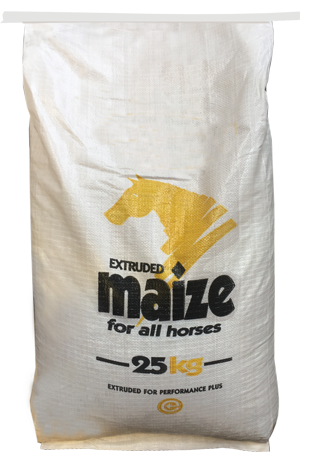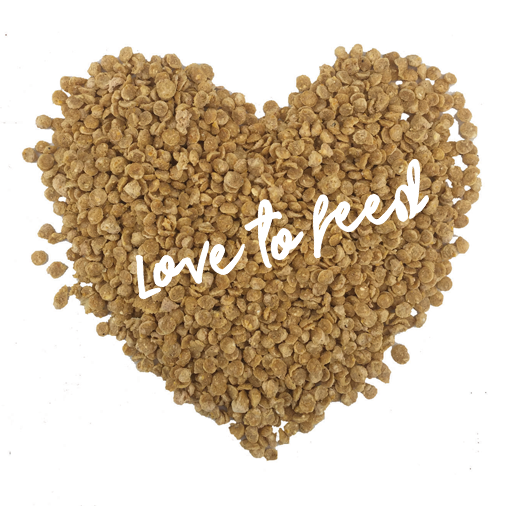- Maize provides an energy-dense supplement feed for horses with increased calorie demands for performance or when requiring weight gain. However, it is not a suitable feed stuff for horses in an uncooked state due to its lack of preceacal digestibly. The extrusion or cooking process, when applied to Maize, raises digestibility in the small intestine from around 30% to 90%. Therefore Dunstan Extruded Maize is a safe way to provide this energy-dense grain to the diets of performance horses, providing them with the necessary ‘fuel’ to perform.
The addition of Vegetable Oil during the extrusion process enhances the energy value of the product whilst adding essential fatty acids to aid cellular integrity and skin and coat appearance.
Dunstan Extruded Maize is presented as small discs and when fed in conjunction with a balanced diet for protein, fibre, minerals and vitamins, provides a highly available energy source for hard-working horses or where an extra condition is required.Equine Safe
Dunstan Horsefeeds are produced in Equine-Safe manufacturing plants, ensuring a product of premium quality, safety and performance.
Professionally formulated for New Zealand horses performing under New Zealand conditions - Coming Soon!
Typical Analysis (dry matter basis)
| Crude Protein | 8.0% |
| Fibre | 3.0% |
| Fat | 5.0% |
| Salt | 0.06% |
| DE | 16.5 MJ/KG |
The recommended feeding rates are based on a 500kg horse and are guidelines only
Racework: Feed 0.5 - 1.5 kg per day depending on race activity.
Conditioning Feed: Feed 0.5 - 1.0 kg per day according to body weight.
- The recommended feeding rates for Dunstan Extruded Maize are based on a 500kg horse and are guidelines only. Daily feed amounts will vary depending on pasture availability and body condition. Horses are very much individuals with different metabolic efficiencies, some require a little more, others a little less, for the same level of activity.
- Ensure adequate fibre intakes by providing 1 % - 1 .5% per day of the horse's body weight as chaff, hay, Dunstan Betabeet/Sugarbeet or pasture (on a Dry Matter basis).
- It is advisable to split the daily hard feed into at least two feeds, preferably 3-4, but feed no more than 0.5kg of Dunstan Extruded Maize per meal.
- Always introduce a new feed gradually over a period of 7 – 10 days, working up to the desired feed intake taking into consideration body condition and work level.
General Notes
Always ensure the horse has access to clean drinking water.
Dunstan Horsefeeds are best used within four months from the time of purchase.
This ensures the vitamins included in Dunstan Horsefeeds remains efficacious to ensure optimum equine health.
However, as is the case with human foods, “fresh is best”. So always aim to feed Dunstan products as fresh as you are able.
A Hint on Storage of Dunstan Horsefeeds:
When storing Dunstan Horsefeeds, it is important that it is kept in a clean, dry, cool and rodent-proof area to avoid potential moulds and/or contaminants.



